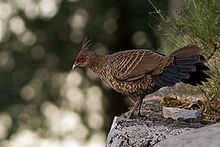Kalij pheasant
| Kalij pheasant | |
|---|---|
 |
|
| Male L. leucomelanos hamiltoni, Naina Devi Himalayan Bird Conservation Reserve, India | |
 |
|
| Female L. leucomelanos hamiltoni, Lingadhar, Uttarakhand, India | |
| Scientific classification | |
| Kingdom: | Animalia |
| Phylum: | Chordata |
| Class: | Aves |
| Order: | Galliformes |
| Family: | Phasianidae |
| Subfamily: | Phasianinae |
| Genus: | Lophura |
| Species: | L. leucomelanos |
| Binomial name | |
|
Lophura leucomelanos (Latham, 1790) |
|
The kalij pheasant (Lophura leucomelanos) is a pheasant found in forests and thickets, especially in the Himalayan foothills, from Pakistan to western Thailand. Males are rather variable depending on the subspecies involved, but all have an at least partially glossy bluish-black plumage, while females are overall brownish. Both sexes have a bare red face and greyish legs (the latter separating it from the red-legged silver pheasant). It is generally common and widespread, though three of its eastern subspecies (oatesi, lineata and crawfurdi) are considered threatened and moffitti is virtually unknown in the wild.
The name is also spelt kaleege in old texts, such as Game Birds of India and Asia by Frank Finn, though no longer in his Indian Sporting Birds. It has also been introduced to Hawaii, where it is considered an invasive species because it consumes and disperses seeds of invasive plant species.
The kalij pheasant is closely related to the silver pheasant and the two are known to hybridize. The placement of the taxa lineata and crawfurdi has been a matter of dispute, with some treating them as subspecies of the kalij pheasant and others as subspecies of the silver pheasant. They have greyish legs as in the kalij pheasant, but their plumage is closer to that of some subspecies of the silver pheasant. Additionally, as the silver pheasant, lineata and crawfurdi are found east of the Irrawaddy River, a major zoogeographic barrier, while all other subspecies of the kalij pheasant are found west of the river (oatesi, a subspecies of the kalij pheasant, has sometimes been reported as occurring east of that river, but this is incorrect). Based on mtDNA, it was recently confirmed that lineata and crawfurdi should be regarded as subspecies of the kalij pheasant.
...
Wikipedia

